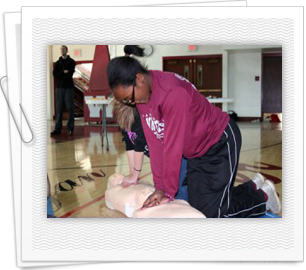Online CPR Certification Blog
The survival rate of ‘hands-only’ CPR
Date: November 19th, 2013
 According to a large study done in Japan, the odds of cardiac arrest victims are going to survive the situation with less brain damage are very low. The researchers said that their findings support some statements made by American Heart Association that the compression only CPR could be a comparable option to traditional technique that involves chest compressions together with mouth to mouth breathing.
According to a large study done in Japan, the odds of cardiac arrest victims are going to survive the situation with less brain damage are very low. The researchers said that their findings support some statements made by American Heart Association that the compression only CPR could be a comparable option to traditional technique that involves chest compressions together with mouth to mouth breathing.
American Heart Association recommends hands only CPR
American Heart Association has since 2008 recommended that bystanders should perform the hands only CPR in case an adult collapses suddenly and unable to breathe. The chest compressions should be steady, strong and performed at a rate of one hundred compressions per minute. This is unless the bystander is confident that he or she can perform the conventional CPR. Their reasoning is that lay people can easily learn and remember the hands- only CPR and people will be more willing to assist strangers as they will not be required to offer mouth to mouth resuscitation. In addition, recent studies have proven that the hands only CPR could be equally effective as the other traditional CPR version used on people with heart problems.
Administering either of these two versions of CPR is very crucial during a cardiac arrest and can go a long way in saving the life of the victim. Cardiac arrest usually results after the heart fails to pump blood to the body and can be the result of drug overdose, breathing problems and drowning. In such cases, it is still recommended that CPR accompany with rescue breaths is involved. However, recent research findings published in journal Resuscitation shows that no matter which CPR technique is used, the chances that the victim will survive without or with serious damage to the brain are still very low.
Prompt action during cardiac arrest is crucial
The researchers used national data of over 55, 000 adults in Japan, who had suffered cardiac arrest at the presence of witnesses. About 7 percent of the patients who received bystander CPR and got paramedics treatment within 15 minutes managed to survive with favorable neurological outcome. Delayed treatment from the paramedics had high chances of leading to survival with significant brain damage. For the patients who weren’t lucky to get CPR, only 0.7 percent of them survived without a moderate brain damage a month later. However, the research findings still stressed on the importance of bystanders performing hands- only CPR.
Dr. Michael Sayre of American Heart Association agreed to these findings and noted that paramedics would normally reach the victim within 15 minutes. He also added that while prompt action was still important from the by- stander, it is still crucial that the bystander call 911 immediately. CPR helps in keeping the blood of cardiac arrest victim flowing until the arrival of emergency help.